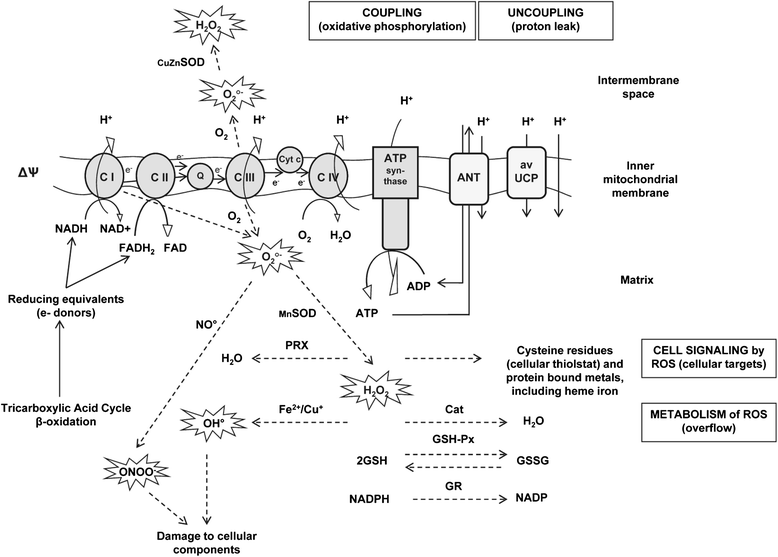Association between heat stress and oxidative stress in poultry; mitochondrial dysfunction and dietary interventions with phytochemicals
- PMID: 27354915
- PMCID: PMC4924307
- DOI: 10.1186/s40104-016-0097-5
Association between heat stress and oxidative stress in poultry; mitochondrial dysfunction and dietary interventions with phytochemicals
Abstract
Heat as a stressor of poultry has been studied extensively for many decades; it affects poultry production on a worldwide basis and has significant impact on well-being and production. More recently, the involvement of heat stress in inducing oxidative stress has received much interest. Oxidative stress is defined as the presence of reactive species in excess of the available antioxidant capacity of animal cells. Reactive species can modify several biologically cellular macromolecules and can interfere with cell signaling pathways. Furthermore, during the last decade, there has been an ever-increasing interest in the use of a wide array of natural feed-delivered phytochemicals that have potential antioxidant properties for poultry. In light of this, the current review aims to (1) summarize the mechanisms through which heat stress triggers excessive superoxide radical production in the mitochondrion and progresses into oxidative stress, (2) illustrate that this pathophysiology is dependent on the intensity and duration of heat stress, (3) present different nutritional strategies for mitigation of mitochondrial dysfunction, with particular focus on antioxidant phytochemicals. Oxidative stress that occurs with heat exposure can be manifest in all parts of the body; however, mitochondrial dysfunction underlies oxidative stress. In the initial phase of acute heat stress, mitochondrial substrate oxidation and electron transport chain activity are increased resulting in excessive superoxide production. During the later stage of acute heat stress, down-regulation of avian uncoupling protein worsens the oxidative stress situation causing mitochondrial dysfunction and tissue damage. Typically, antioxidant enzyme activities are upregulated. Chronic heat stress, however, leads to downsizing of mitochondrial metabolic oxidative capacity, up-regulation of avian uncoupling protein, a clear alteration in the pattern of antioxidant enzyme activities, and depletion of antioxidant reserves. Some phytochemicals, such as various types of flavonoids and related compounds, were shown to be beneficial in chronic heat-stressed poultry, but were less or not effective in non-heat-stressed counterparts. This supports the contention that antioxidant phytochemicals have potential under challenging conditions. Though substantial progress has been made in our understanding of the association between heat stress and oxidative stress, the means by which phytochemicals can alleviate oxidative stress have been sparsely explored.
Keywords: Antioxidant enzymes; Avian uncoupling protein; Electron transport chain; Flavonoids; Heat Stress; Mitochondrion; Oxidative stress; Poultry.
Figures

References
-
- Yahav S. Alleviating heat stress in domestic fowl: different strategies. World’s Poult Sci J. 2009;65:719–732. doi: 10.1017/S004393390900049X. - DOI
-
- Syafwan S, Kwakkel RP, Verstegen MWA. Heat stress and feeding strategies in meat-type chickens. World’s Poult Sci J. 2011;67:653–673. doi: 10.1017/S0043933911000742. - DOI
-
- Lin H, Jiao HC, Buyse J, Decuypere E. Strategies for preventing heat stress in poultry. World’s Poult Sci J. 2006;62:71–86. doi: 10.1079/WPS200585. - DOI
Publication types
LinkOut - more resources
Full Text Sources
Other Literature Sources

